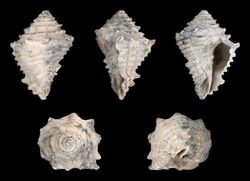Biology:Hystrivasum horridum
| Hystrivasum horridum | |
|---|---|

| |
| Hystrivasu horridum Heilprin from the Pliestiocene of Florida | |
| Scientific classification | |
| Kingdom: | |
| Phylum: | |
| Class: | |
| (unranked): | |
| Superfamily: | |
| Family: | |
| Subfamily: | |
| Genus: | |
| Species: | H. horridum
|
| Binomial name | |
| Hystrivasum horridum (Heilprin, 1886)
| |
Hystrivasum horridum, common name the rough or shaggy vase, is a fossil species of medium-sized predatory gastropod in the family Turbinellidae. This species is extinct and is found in the Pleistocene deposits of Florida.
Etymology
The specific name horridum is Latin for "rough" or "shaggy" and does not mean "horrid".
Shell description
Like other species in the subfamily Vasinae, Hystrivasum horridum shells are large, thick and heavy. They are vase-shaped, in the sense that they are biconical. The shells have moderate spires, and have several plaits on the columella.
Hystrivasum horridum, formerly Vasum horridum, belongs to an extinct group that is easily distinguished from modern Vasum by the presence of two sets of spines or nodes located on the shoulder of the whorls. These spines can be found at the suture and at the periphery of the shoulder. H. horridum has 12-15 wide, scoop-like spines that project almost horizontally from the shoulder. Also, H. horridum has a pronounced "waist-like" constriction at the base of the shell. These characteristics set it apart from other members of the group.[1]
Hystrivasum horridum is known only from the Pleistocene of Florida. It is "one of the most characteristic and elegant fossils of the Caloosahatchee marl."[2] It was first described by Angelo Heilprin in 1886. The famous malacologist William Healey Dall stated that this "magnificent species seems to be confined to [the Pliocene Caloosahatchie Beds] and to have given rise to no descendant in the recent fauna.”[3]
See also
References
- ↑ Vokes E. H. 1966. The genus Vasum (Mollusca: Gastropoda) in the new world. Tulane Studies in Geology and Paleontology, 5(1):1-35. page 23.
- ↑ DuBar J. R. 1958. Stratigraphy and paleontology of the late Neogene strata of the Caloosahatchee River area of Southern Florida, Florida Geological Survey, page 190.
- ↑ Dall W. H. 1890. Contributions to the Tertiary Fauna of Florida with special reference to the Miocene Silex Beds of Tampa and the Pliocene Beds of the Caloosahatchie River. The Transactions of the Wagner Free Institute of Science of Philadelphia, page 99.
Wikidata ☰ Q5962431 entry
 |

